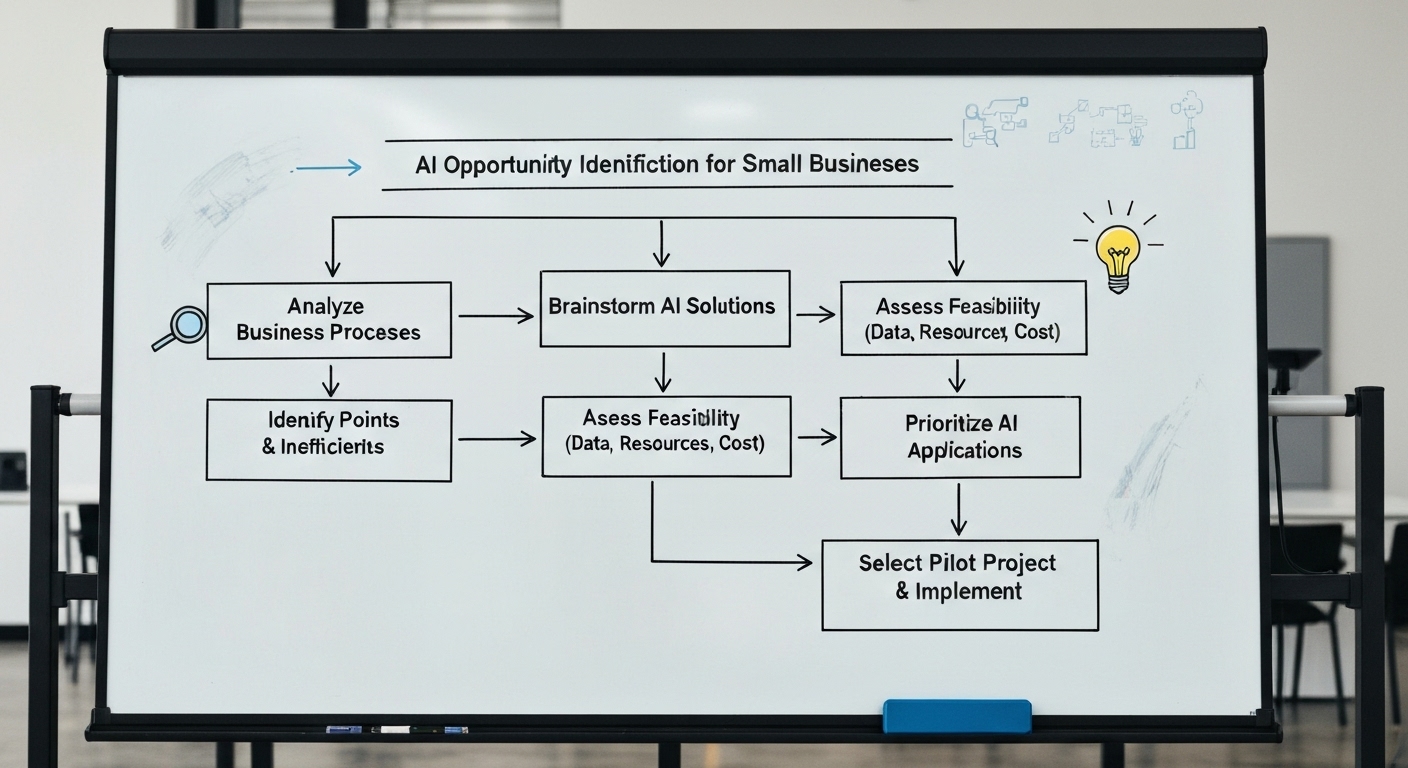How to Implement AI in a Small Business : A Practical Guide
how to implement ai in a small business requires careful planning and execution. This comprehensive guide will walk you through the steps needed to successfully integrate artificial intelligence into your small business, helping you boost efficiency, improve customer experience, and gain a competitive edge.
Understanding AI and Its Potential for Small Businesses
Artificial Intelligence (AI) is no longer a futuristic concept; it’s a present-day reality with the potential to revolutionize how small businesses operate. From automating mundane tasks to providing data-driven insights, AI offers a range of opportunities. Understanding these opportunities is the first step toward successful implementation.

What is Artificial Intelligence?
At its core, AI is about creating machines that can perform tasks that typically require human intelligence. This includes learning, problem-solving, decision-making, and even understanding natural language.
Benefits of AI for Small Business
The benefits of implementing AI are numerous and can significantly impact various aspects of your business:
- Increased Efficiency: Automate repetitive tasks, freeing up employees for more strategic work.
- Improved Customer Service: Provide 24/7 customer support through chatbots and personalized recommendations.
- Data-Driven Decisions: Gain insights from data analysis to make informed business decisions.
- Enhanced Marketing: Personalize marketing campaigns for better targeting and higher conversion rates.
- Cost Reduction: Optimize operations and reduce errors, leading to cost savings.
Identifying AI Opportunities in Your Business
Before diving into implementation, it’s crucial to identify specific areas where AI can provide the most value. Consider processes that are time-consuming, data-heavy, or require a high degree of accuracy.

Analyzing Your Business Processes
Start by mapping out your key business processes, such as customer service, sales, marketing, and operations. Identify bottlenecks, pain points, and areas where automation could improve efficiency.
Examples of AI Applications for Small Businesses
Here are some examples of how AI can be applied in different areas:
- Customer Service: AI-powered chatbots to handle basic inquiries and provide instant support.
- Marketing: AI algorithms to personalize email marketing campaigns and target specific customer segments.
- Sales: Predictive analytics to identify potential leads and forecast sales trends.
- Operations: Machine learning to optimize inventory management and predict equipment failures.
- Finance: AI to automate invoice processing and detect fraudulent transactions.
Choosing the Right AI Tools and Solutions
Selecting the right AI tools is essential for successful implementation. There are numerous AI solutions available, each with its own strengths and weaknesses. Consider your specific needs, budget, and technical expertise when making your choice.

Types of AI Tools for Small Business
Here are some common types of AI tools that are suitable for small businesses:
- Chatbots: Platforms like Dialogflow and ManyChat allow you to create AI-powered chatbots for customer service and sales.
- CRM Systems with AI: Platforms like Salesforce and HubSpot offer AI-powered features such as lead scoring and sales forecasting.
- Marketing Automation Tools: Tools like Marketo and ActiveCampaign use AI to personalize marketing campaigns and automate tasks.
- Analytics Platforms: Platforms like Google Analytics and Tableau provide AI-driven insights into website traffic and customer behavior.
- Machine Learning Platforms: Cloud-based platforms like AWS SageMaker and Google Cloud AI Platform allow you to build and deploy custom AI models.
Factors to Consider When Choosing AI Tools
When evaluating AI tools, consider the following factors:
- Ease of Use: Choose tools that are easy to use and don’t require extensive technical expertise.
- Integration: Ensure that the tool integrates seamlessly with your existing systems and workflows.
- Scalability: Select a tool that can scale as your business grows.
- Cost: Consider the cost of the tool, including subscription fees, implementation costs, and ongoing maintenance.
- Support: Look for tools that offer reliable customer support and documentation.
Developing an AI Implementation Strategy
A well-defined implementation strategy is crucial for a successful AI project. This strategy should outline your goals, timelines, resources, and key performance indicators (KPIs).
Setting Clear Goals and Objectives
Define specific, measurable, achievable, relevant, and time-bound (SMART) goals for your AI implementation. For example, you might aim to reduce customer service response time by 20% within six months.
Creating a Timeline and Budget
Develop a realistic timeline for your AI project, including milestones and deadlines. Allocate a budget for software, hardware, training, and consulting services.
Assembling a Team
Identify the individuals who will be responsible for implementing and managing the AI system. This team may include IT professionals, data scientists, and business analysts.
Data Preparation and Management
AI models require data to learn and make predictions. Ensure that you have a process in place for collecting, cleaning, and managing your data. Consider using a data management platform to streamline this process.
Training Your Team and Integrating AI into Workflows
Implementing AI successfully requires training your team to use the new tools and integrating AI into existing workflows. This may involve providing training sessions, creating documentation, and adjusting job roles.

Providing Training and Support
Offer training sessions to teach your employees how to use the AI tools and understand their capabilities. Provide ongoing support to address any questions or issues that arise.
Adjusting Workflows and Processes
Modify your existing workflows to incorporate AI-powered tasks. This may involve automating certain steps, providing employees with AI-driven insights, or using AI to augment human decision-making.
Monitoring and Evaluating Results
Regularly monitor and evaluate the performance of your AI system to ensure that it’s meeting your goals. Track key performance indicators (KPIs) and make adjustments as needed.
Overcoming Common Challenges in AI Implementation
Implementing AI can be challenging, but by anticipating potential obstacles and developing strategies to overcome them, you can increase your chances of success.
Data Quality Issues
Poor data quality can significantly impact the performance of your AI models. Ensure that your data is accurate, complete, and consistent.
Lack of Technical Expertise
If you lack in-house technical expertise, consider hiring a consultant or partnering with an AI solutions provider. Another option is to explore cloud-based AI platforms that offer user-friendly interfaces and pre-built models.
Resistance to Change
Some employees may be resistant to adopting new technologies. Address their concerns by communicating the benefits of AI and involving them in the implementation process.
Cost Considerations
AI implementation can be expensive, but there are ways to minimize costs. Start with small-scale projects, leverage open-source tools, and explore cloud-based solutions.
Real-World Examples of AI in Small Businesses
Many small businesses are already reaping the benefits of AI. Here are a few examples:
E-commerce Personalization
An online retailer uses AI to personalize product recommendations and offers based on customer browsing history and purchase behavior. This has led to a 15% increase in sales.
Restaurant Chatbot
A local restaurant uses a chatbot to take reservations, answer questions about the menu, and provide directions. This has reduced the workload on the front-of-house staff and improved customer satisfaction.
Marketing Automation
A marketing agency uses AI to automate email marketing campaigns, personalize content, and track results. This has freed up time for the team to focus on more strategic initiatives.
The Future of AI in Small Business
AI is constantly evolving, and its role in small businesses will only continue to grow. As AI technologies become more accessible and affordable, small businesses will be able to leverage them to gain a competitive edge and drive growth.
Emerging AI Trends
Keep an eye on emerging AI trends, such as:
- Generative AI: AI models that can generate new content, such as text, images, and videos.
- Edge AI: AI processing that is performed on devices at the edge of the network, rather than in the cloud.
- Explainable AI: AI models that can explain their decision-making process, making them more transparent and trustworthy.
By staying informed and embracing new technologies, small businesses can unlock the full potential of AI.
Conclusion
How to implement ai in a small business is a journey that requires careful planning, execution, and ongoing evaluation. By understanding the potential of AI, identifying opportunities, choosing the right tools, and developing a solid implementation strategy, you can successfully integrate AI into your business and reap the many benefits it offers. Remember to start small, focus on specific goals, and continuously monitor your results. AI can be a powerful tool for small businesses looking to improve efficiency, enhance customer experience, and achieve sustainable growth. Don’t be afraid to experiment and adapt as you learn more about what works best for your unique business needs. You can find further information about AI implementation on nist.gov.
For innovative cloud solutions and further insights on leveraging technology for your business, explore flashs.cloud.
HOTLINE
+84372 005 899


